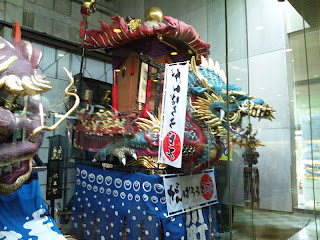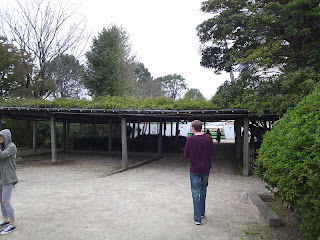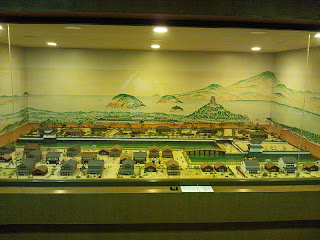The festival is like Kunchi in Nagasaki, if you are interested there is a short video showing some of the sights and floats that you can watch on youtube here: http://www.youtube.com/watch?v=kpag9Lt3EcQ&feature=fvst it shows the parade and it pretty interesting.
Below are the floats that were displayed where they rest between festivals. (the last one is shown from two different angles because it was my favorite).
In the gift shop I found a few interesting things such as this:
If you've ever wished Spider-man was part squid Japan has you covered.
These are candy versions of the floats, I did get one later, they're not bad, but they are made mostly using gumballs, so the simple satisfaction of just eating it is lost.
When we finished in the gift shop we made our way out and across the street to look at a Shinto Shrine. While I feel like I post a lot of pictures about various shrines they are all unique, and so far I have not gotten tired of looking at them. There was also a beautiful little girl there in a kimono who was attending for some ritual that occurs several times as they grow up, ages 3, 4, and 7 I think.
This is Chantel in the foreground, she was trying to restrain herself from kidnapping the little girl.
This is the most interesting basin for purifying yourself (by washing your hands) that I have seen so far.
I just loved the artistic style of this pair of Koma-inu
This is a window to buy blessings and charms among other services offered by the shrine.
I just loved the artistic style of this pair of Koma-inu
This is a window to buy blessings and charms among other services offered by the shrine.
After leaving we made our way to a rather large restaurant that sits above a market. Over half the market was dedicated to sea food and many of the items, such as crabs were still alive, even some rather large fish were left swimming in tanks so they could be sold at the peak of freshness. Going upstairs we were treated to a traditional Japanese meal (which I personally love) with sashimi, a type of custard (not the sweet kind), rice, cooked fish, vegetables, tempura, and soup.
After lunch we went to Eshie, a maker of chicken meatballs. We were not allowed to take pictures, which is unfortunate, because many of the illustrations made it appear as if cute little meatballs ran the factory and were selling their children for consumption, it was funny and disturbing all at the same time. While there was nothing terribly interesting it was fun to see the Japanese work ethic in practice. Purity seems to be a real issue, I assume deriving from Shinto, but even when trucks come in to make deliveries or pick-ups the tires are sprayed with alcohol to sterilize them. At the end we were treated to bowls full of meatballs, which several of us ate the bulk of thanks to the majority of people in our group having to weak a constitution to eat them after seeing how they were made. They were delicious. The people also gave us food as a parting gift for visiting. Very nice people.
From there we headed out to Karatsu Castle. The original castle was started in 1602 and completed in 1609. It was built by Terasawa Shimanokami Hirotaka, a former retainer of Toyotomi Hideyoshi (Toyotomi Hideyoshi, Tokugawa Ieyasu, and Oda Nobunaga were the big three near the end of the warring states period before Tokugawa assumed control as the Shogun and ushered in Japan's period of isolation). It is said some of the materials were taken from Nagoya Castle as it was dismantled when Tokugawa came to power. The original castle was later demolished in 1872 (shortly after the fall of the han system and the rise of the current prefectural system) and this new replica was finished in 1966. We were not allowed to take pictures of any of the floors beside the first and then out the windows of the top floor. I am hoping later when I have a chance to visit some of the other castles in Japan that this is not the case.
And so our day in Karatsu came to an end. I wish I could have taken pictures on the weapons on the second floor and the paintings on the third, but I tend to be more respectful of authority here than I would in the US and so I refrained. This experience did make me want to check out more castles over the break though when I do some traveling, hopefully I'll be able to get more pictures then.
From there we headed out to Karatsu Castle. The original castle was started in 1602 and completed in 1609. It was built by Terasawa Shimanokami Hirotaka, a former retainer of Toyotomi Hideyoshi (Toyotomi Hideyoshi, Tokugawa Ieyasu, and Oda Nobunaga were the big three near the end of the warring states period before Tokugawa assumed control as the Shogun and ushered in Japan's period of isolation). It is said some of the materials were taken from Nagoya Castle as it was dismantled when Tokugawa came to power. The original castle was later demolished in 1872 (shortly after the fall of the han system and the rise of the current prefectural system) and this new replica was finished in 1966. We were not allowed to take pictures of any of the floors beside the first and then out the windows of the top floor. I am hoping later when I have a chance to visit some of the other castles in Japan that this is not the case.
Those are some high walls
Japanese Castles are not what most westerners think of as a "castle"
The main gate
Samurai Kabuto
I wish I knew what this what, but I don't
This model shows what the castle looked like in period
The rest of these pictures show the view from the top of the castle
And so our day in Karatsu came to an end. I wish I could have taken pictures on the weapons on the second floor and the paintings on the third, but I tend to be more respectful of authority here than I would in the US and so I refrained. This experience did make me want to check out more castles over the break though when I do some traveling, hopefully I'll be able to get more pictures then.















































No comments:
Post a Comment